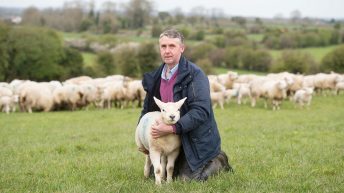Irish farming enjoys a reputation for pasture based, grass fed livestock systems. The marketing power of this image is something Irish food producers and retailers are acutely aware of. Meat and dairy product with pictures of farmers with animals in the field are a common feature of all Irish supermarkets.
This image of open pastoral farming ignores the reality of intensive poultry and pig farming in Ireland, while beef and lamb comes complete with a picture of a farmer with his stock in the field there is no picture on pork or poultry packets. The reason for this is quite simple the image of thousands of birds or pigs in cramped pens in a single house is not one we are supposed to think of while shopping, it’s much better if we think of happy sheep and cattle.

The reality is that Ireland like the rest of the world has a large intensive agriculture sector. The rise of mega farms in Europe has been highlighted by journalists in the UK and France and NGOs including food and water Europe and Friends of the Earth. These mega farms were first identified in the USA as intensive farms which contain more than 125,000 broiler chickens, 82,000 laying hens, and 2,500 pigs, 700 dairy or 1,000 beef cattle. Intensive pig and poultry farms of this scale are not unknown in Ireland.
Irish intensive farming
Irish intensive farming has seen the concentration of the majority of the Irish pig herd in a small number of farms with 45% of the entire pig population in Ireland being kept in just 47 herds of over 10,000 pigs. This has meant that pigs have become an almost unknown feature in many parts of the Irish countryside despite pork production being a significant part of Ireland’s agriculture economy.
Cavan, the county with the largest number of pigs in Ireland 18% of the entire pig population, nearly 300,000 pigs, has an average herd size of 3000 pigs. While the percentage of pigs kept in small backyard herds of 5 or less or smaller intensive herds of under 1000 is less than 2% of the pig population. Small herds of 5 or despite representing less than 1% of the pig population still represent 67% of active pig herds. in comparison only 40 farms had intensive herds of less than 1000 pigs.

Irish poultry is similarly defined by an intensive style of farming with over 10 million birds on 8,250 farms, the majority some 7 million birds and 4000 farms are in the border Midlands and West region. Meaning the average poultry farm in Ireland has over 1200 birds, exact data on the various sizes of poultry farms in the republic is not available online however the situation in poultry farming in the north has been document by Compassion in World Farming. There are over the 6 counties there are over 20 million poultry birds in intensive farms. With the highest concentrations in Tyrone and Antrim.
Pig and poultry farming north and south is an intensive activity which is becoming even more intensive, there is a clear trend in intensive farming towards larger herds and more mega farms as farmers double down in an attempt to maintain profit. So far intensive farming is confined to pig and poultry farming with only a small number of intensive dairy and beef farms in Ireland
The massive scale of these intensive farms and the high concentration of thousands of animals in single sheds raises isn’t just bad for the animals who are kept in unnatural and cramped conditions. It also threatens human health as the animals as factory farmed meat is less nutrient dense and the excessive use of antibiotics in intensive farming reduces the effectiveness of antibiotics. While the cramped conditions make it easier for disease to spread.
The is of course also a serious environmental impact as well as pollution from mega farms threatens rivers and lakes, while the concentration of animals in unnatural intensive farms also threatens biodiversity as animals are removed from their natural settings and more land is needed to produce grain to feed animals in factory farms, the threat to biodivesity from intensive agriculture has been identified by the UNFAO who highlight the role of factory farming in climate change and habitat loss.

The defenders of the status quo point to factory farming being an economic necessity to produce food at a low cost, and point to the jobs created by intensive farming. These arguments ignore the negative impact mega farms have on rural communities who as well as having to live with the effects of increased pollution such as reduced air quality also suffer from the loss of income as smaller less intensive farms are pushed out and the local economy becomes dominated by factory farming jobs which rely on a low paid flexible workforce.
The challenge to feed the worlds growing population is a real one which requires sustainable efficient food production. It is hard to see how an agriculture system which drives deforestation, increases pollution, takes grain from local markets in the global south, and relies on an under paid workforce can provide the type of sustainable change needed to feed the world.
Irish agriculture should be focused on Irish food security and ensuring that rural communities continue to have a sustainable economic base. It is in our interest to promote sustainable farming models that will keep people in rural Ireland and ensure that Irish people have access to healthy nutrient dense food.
